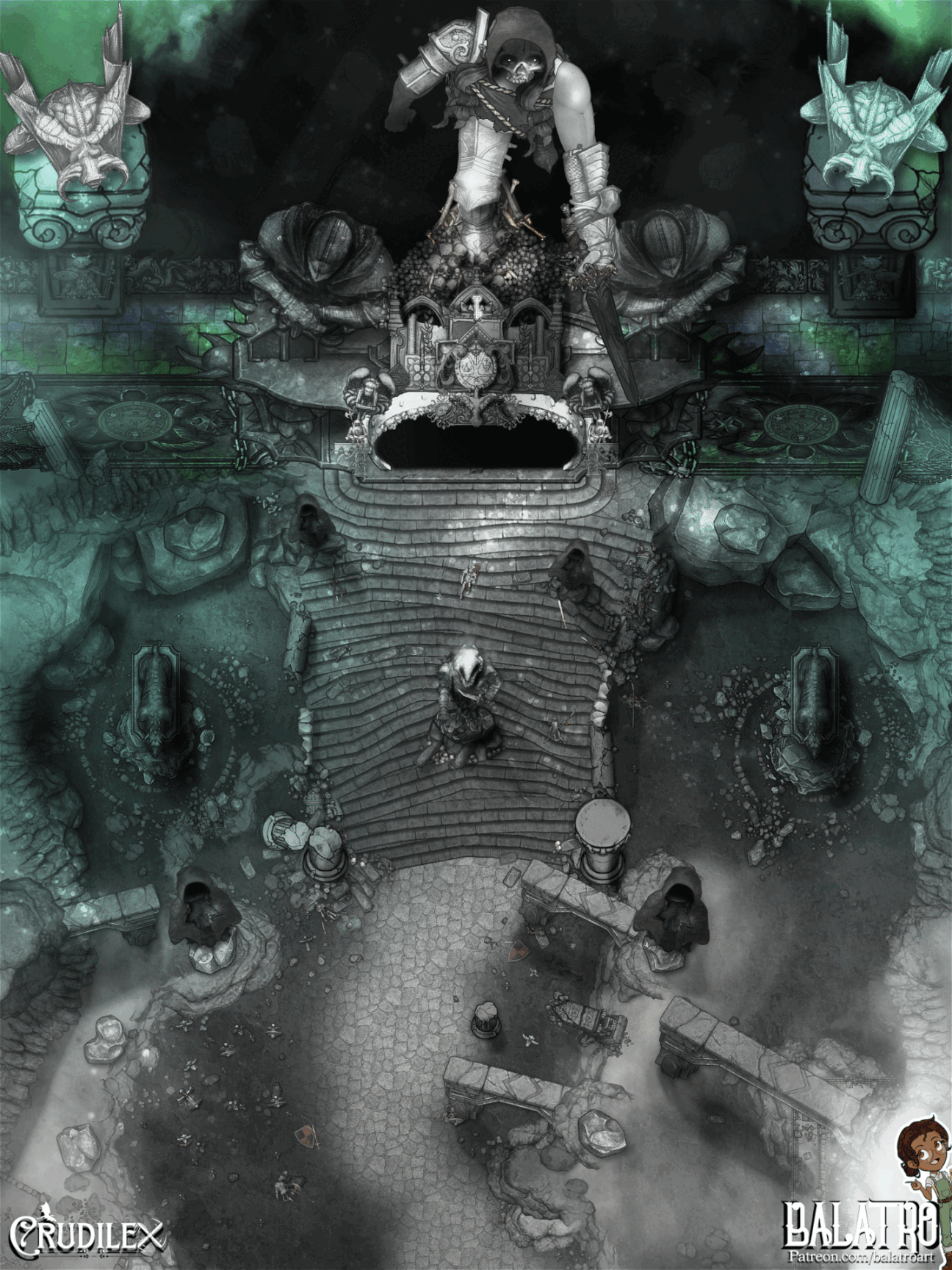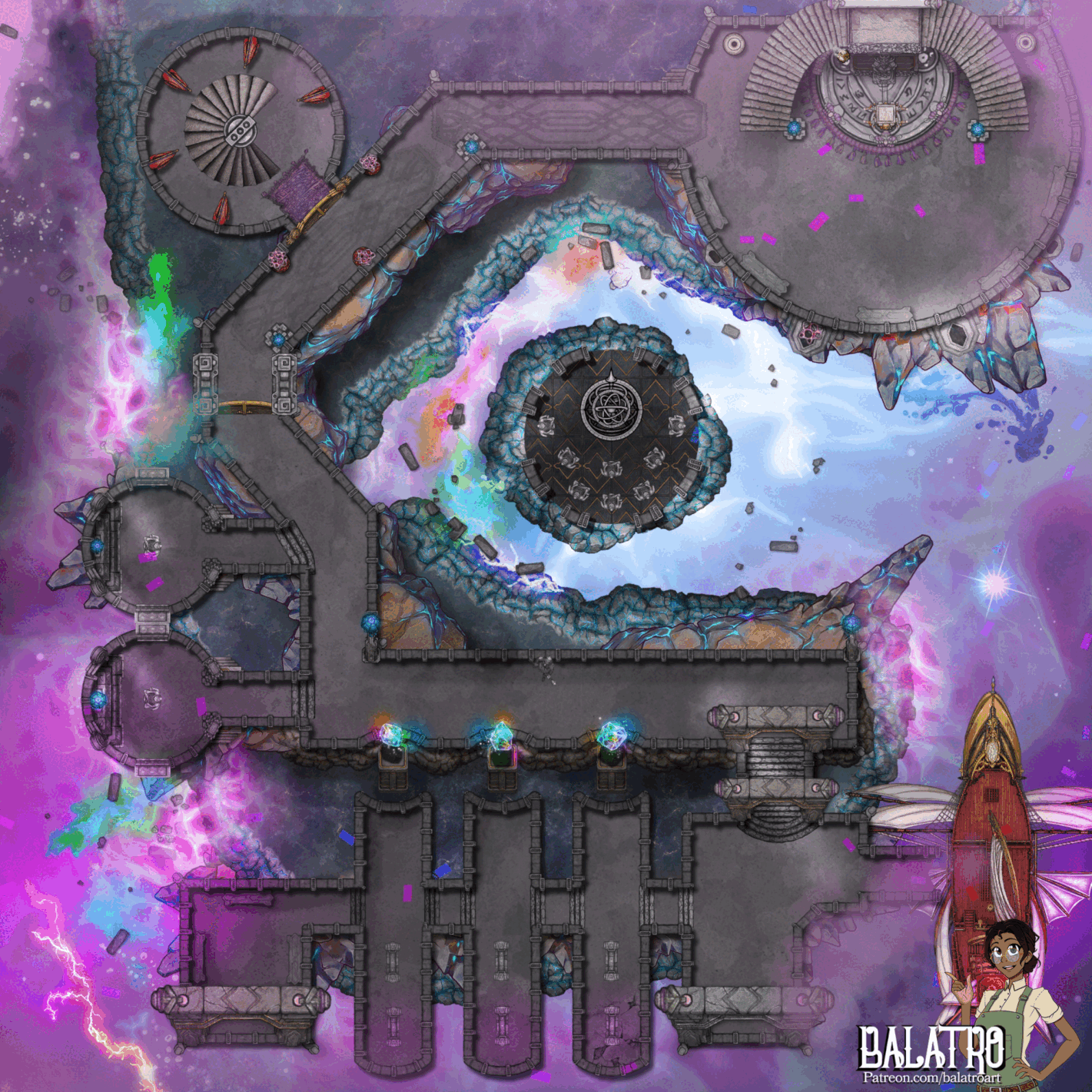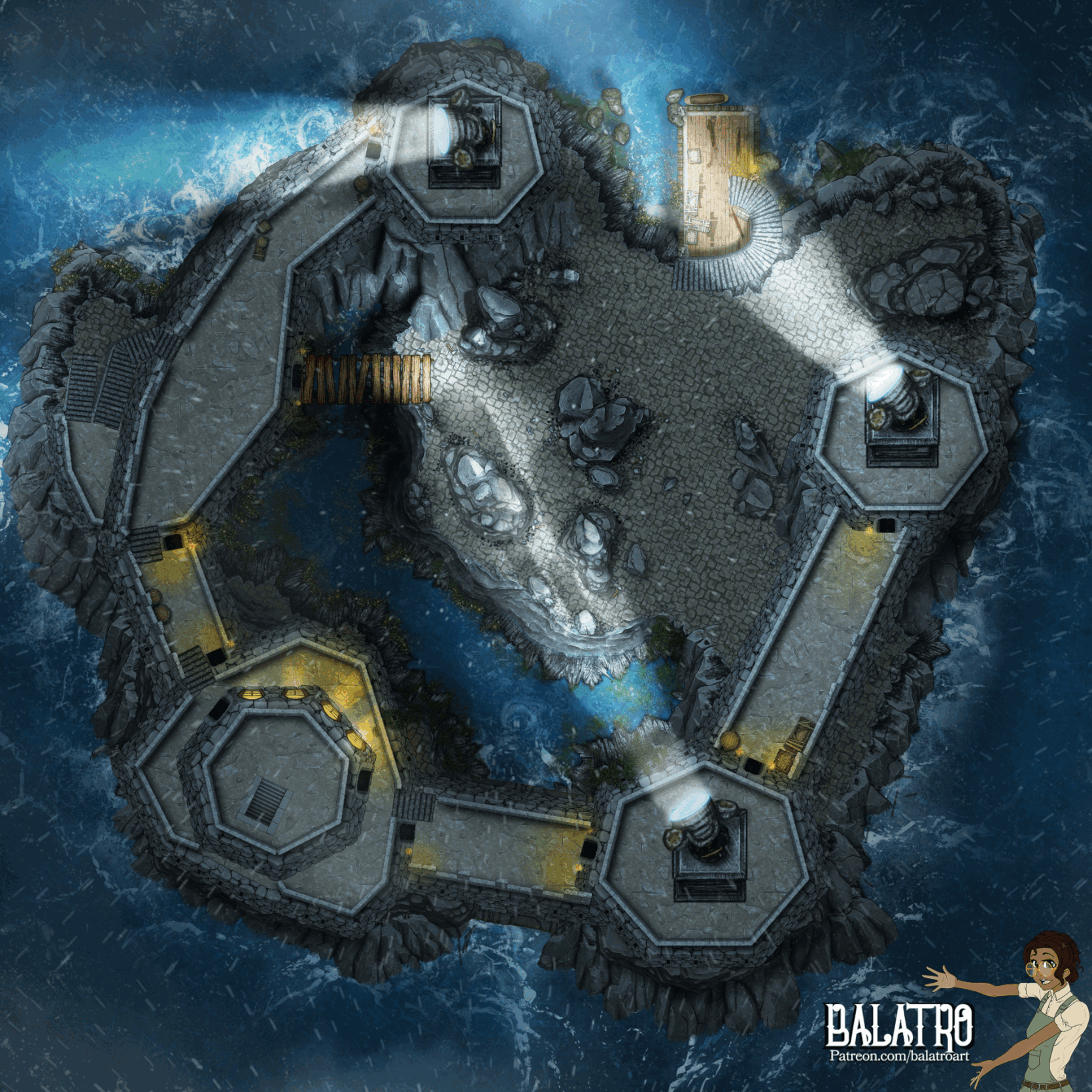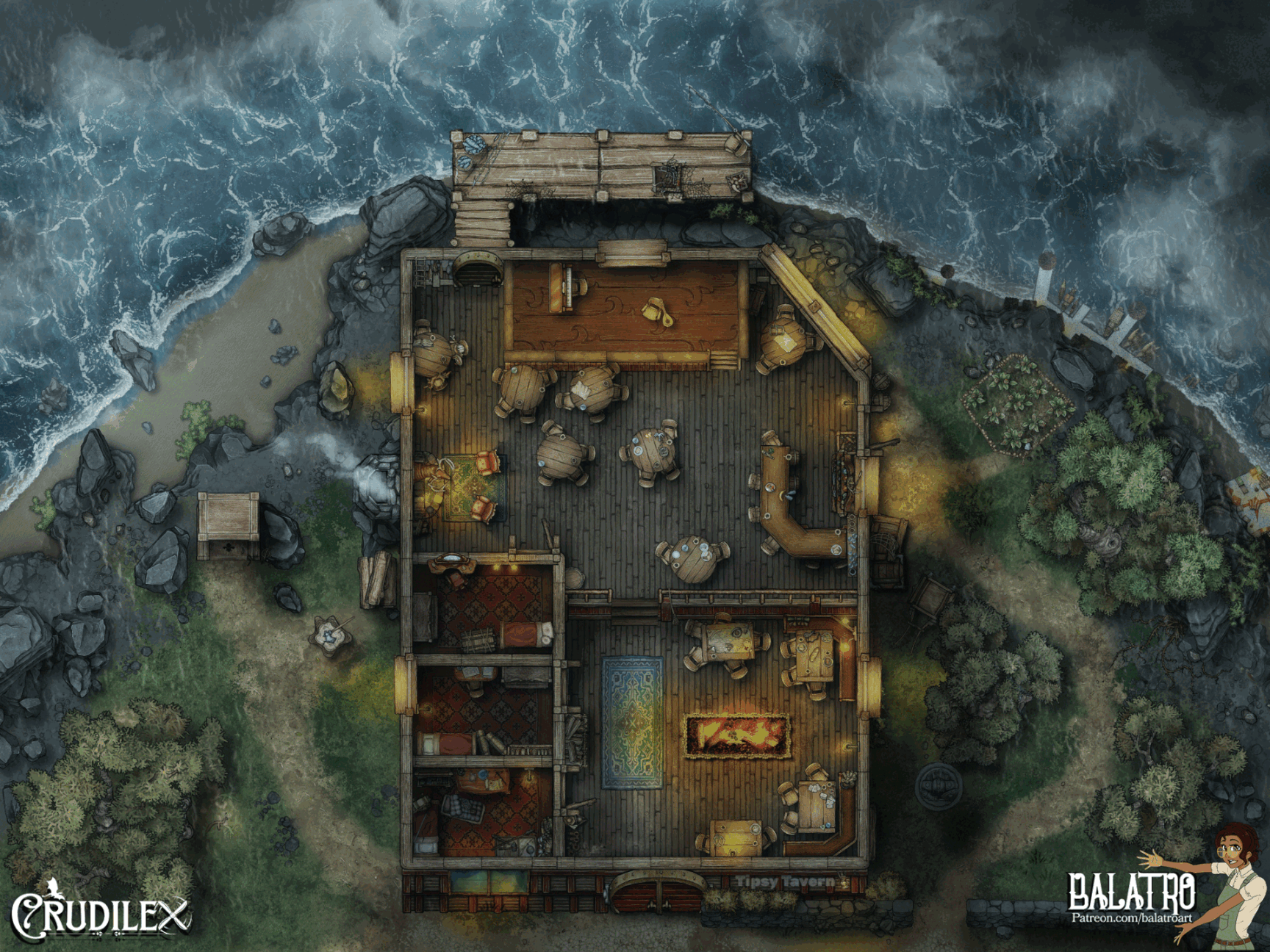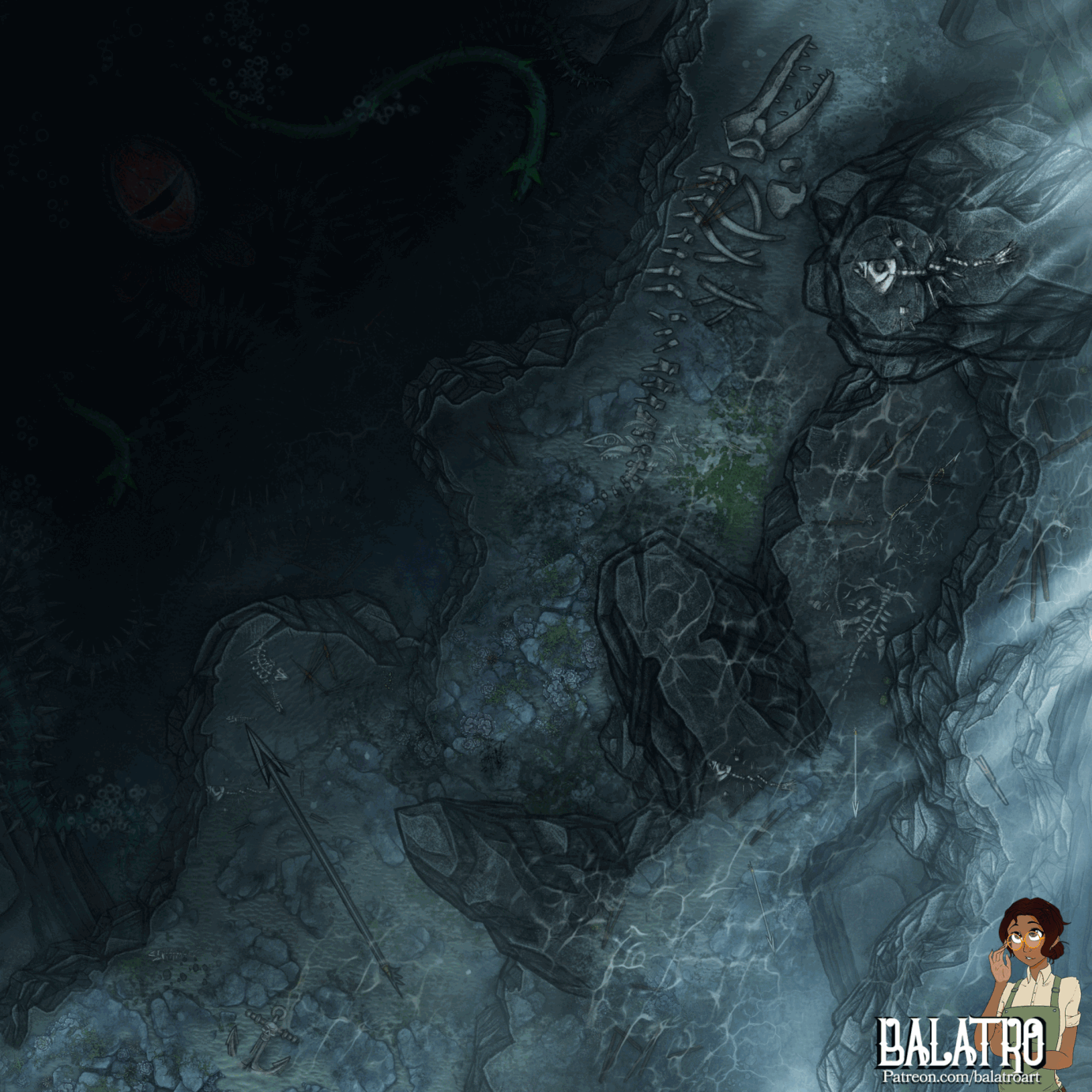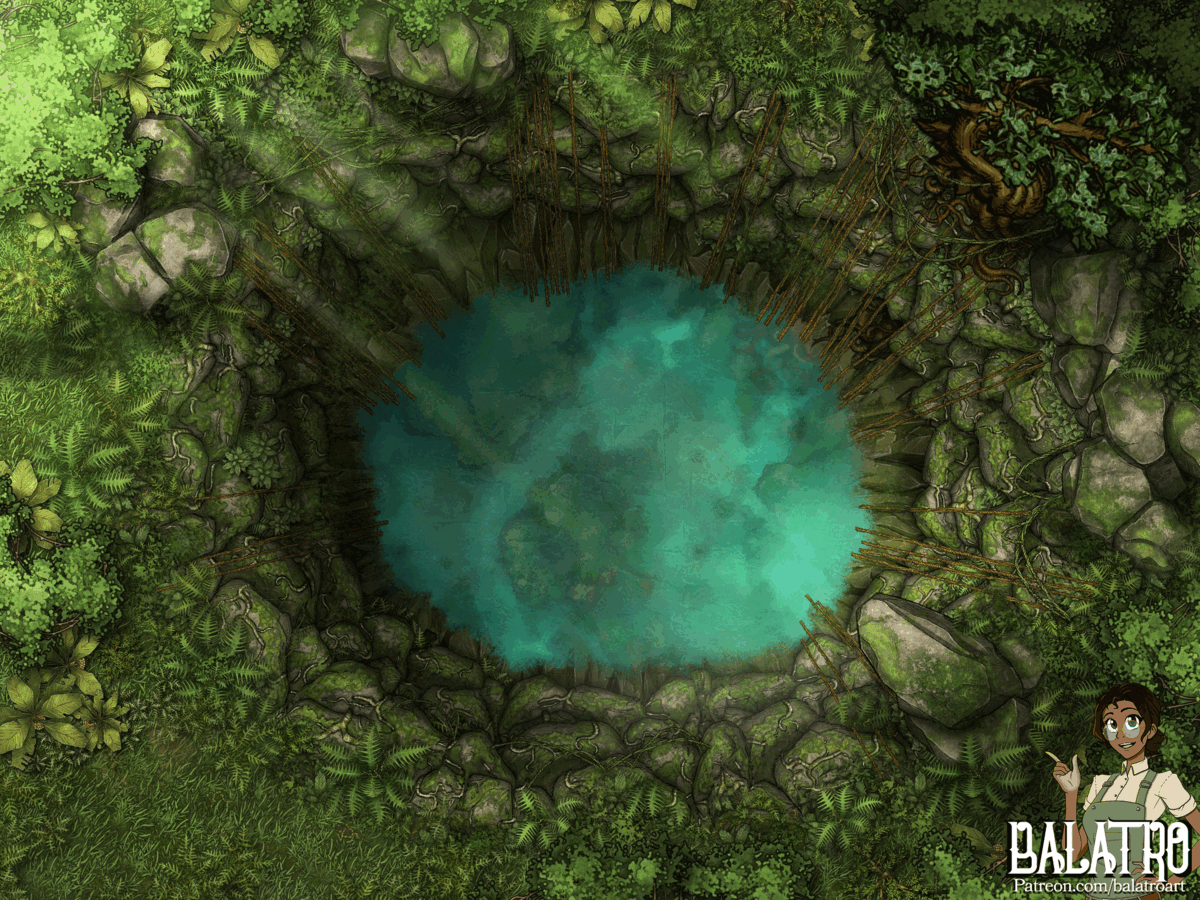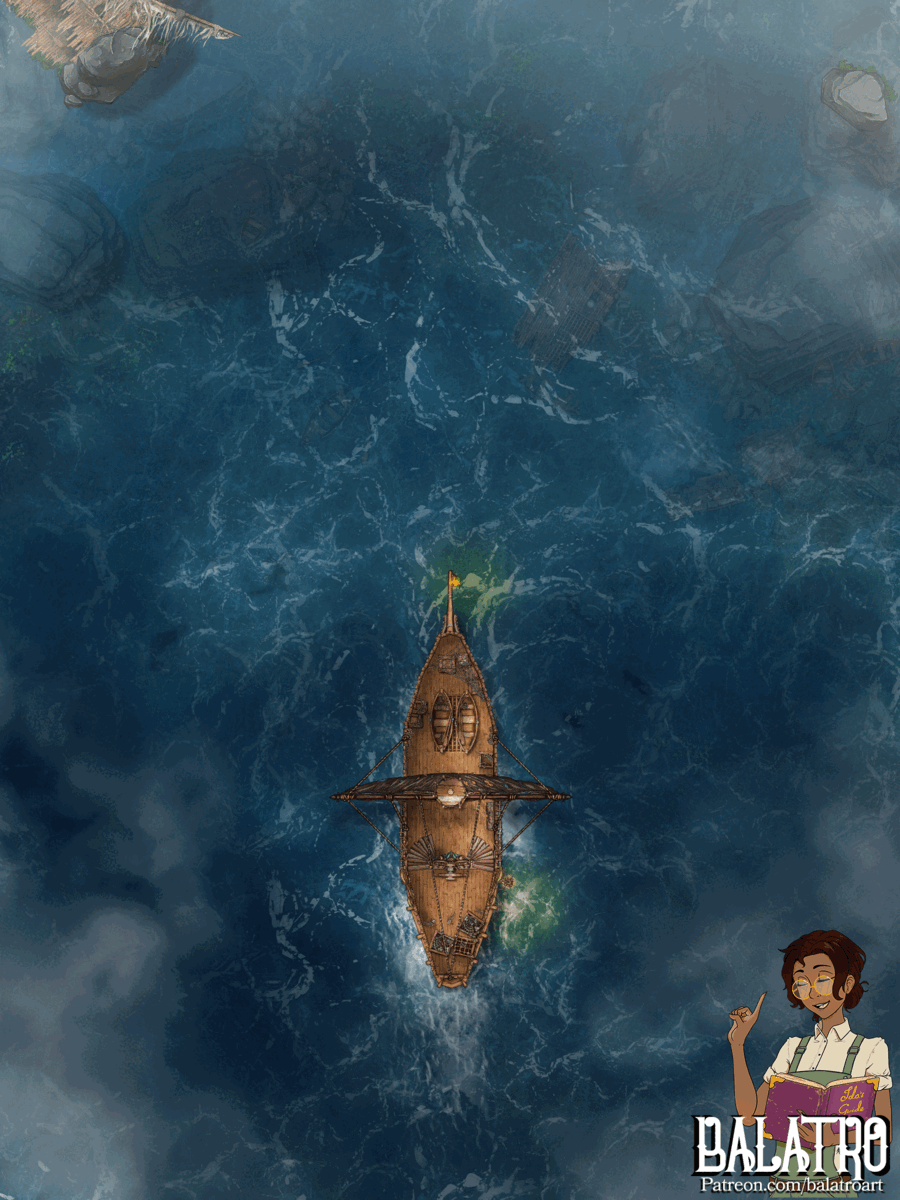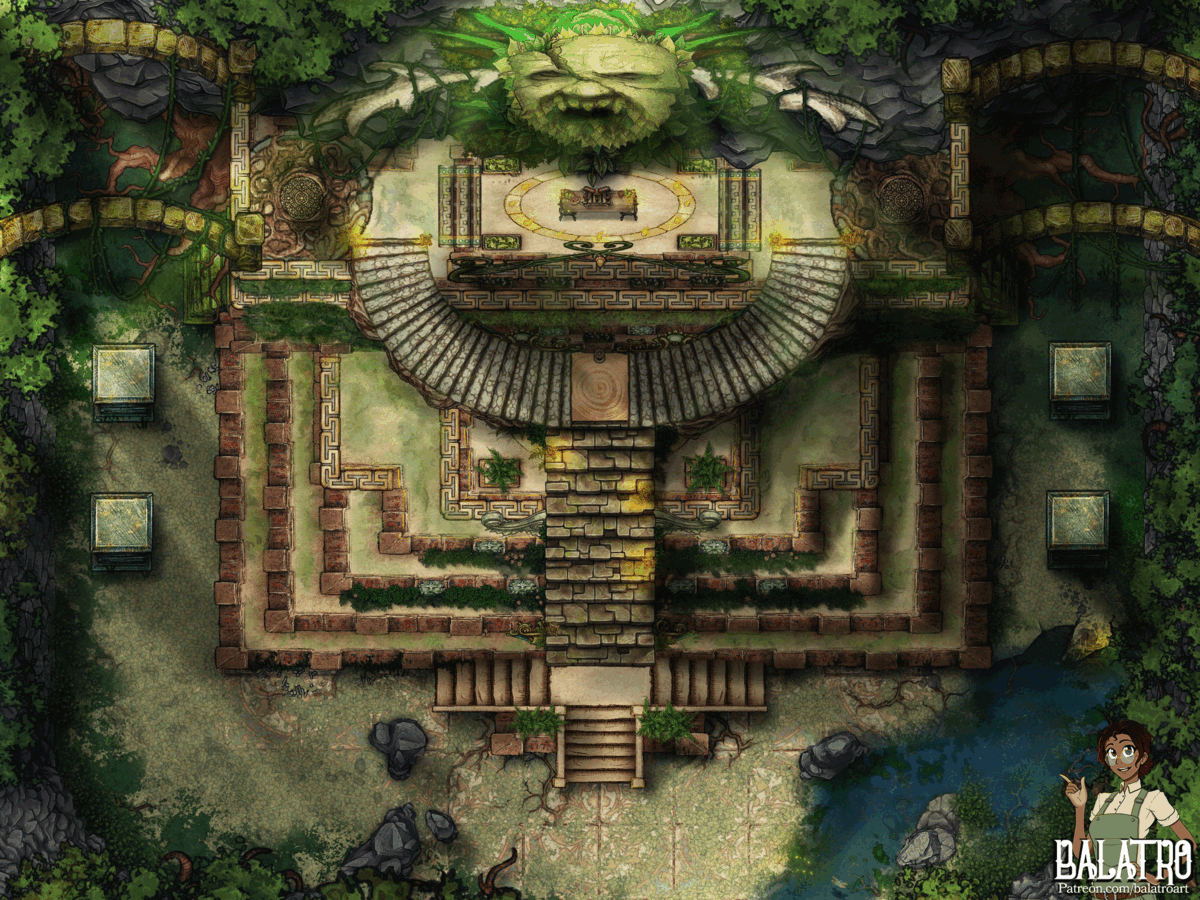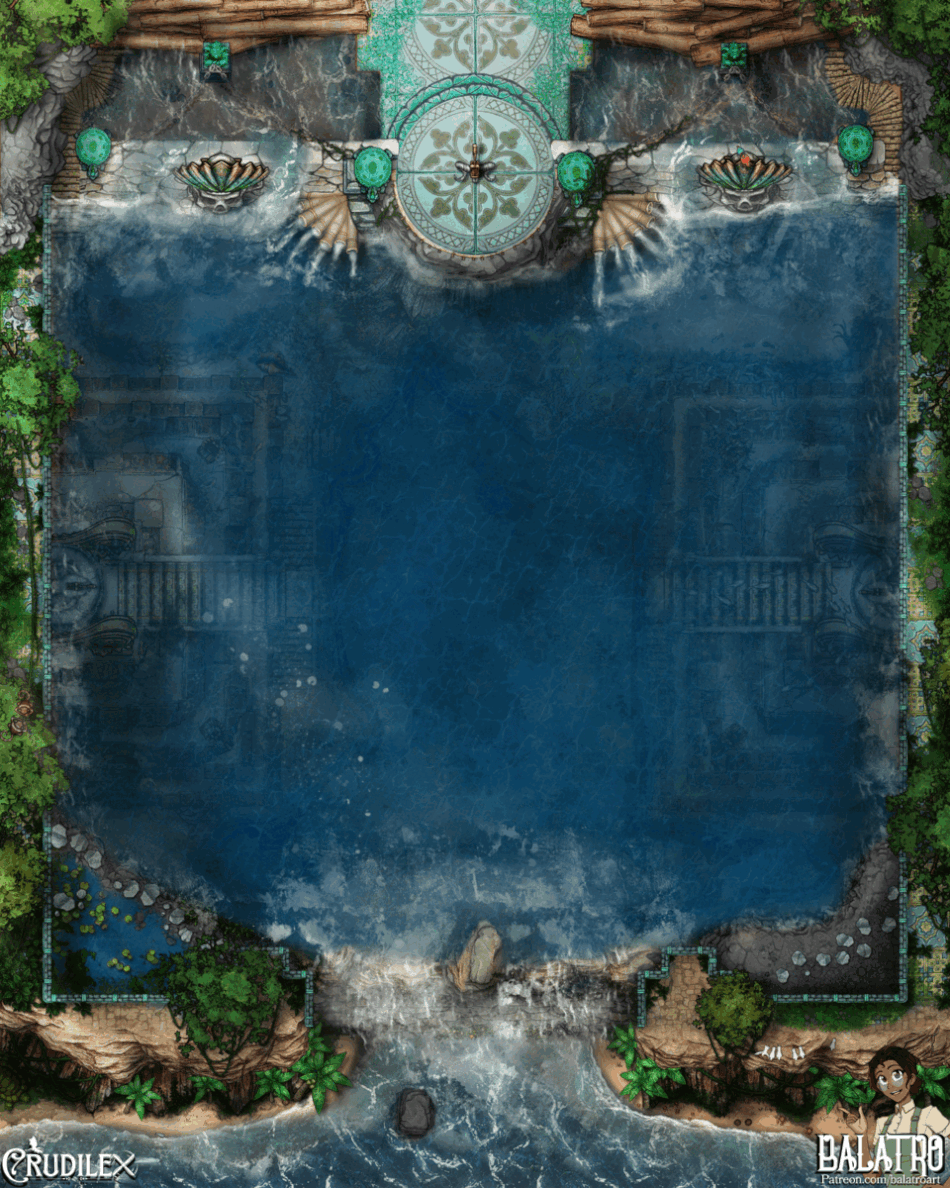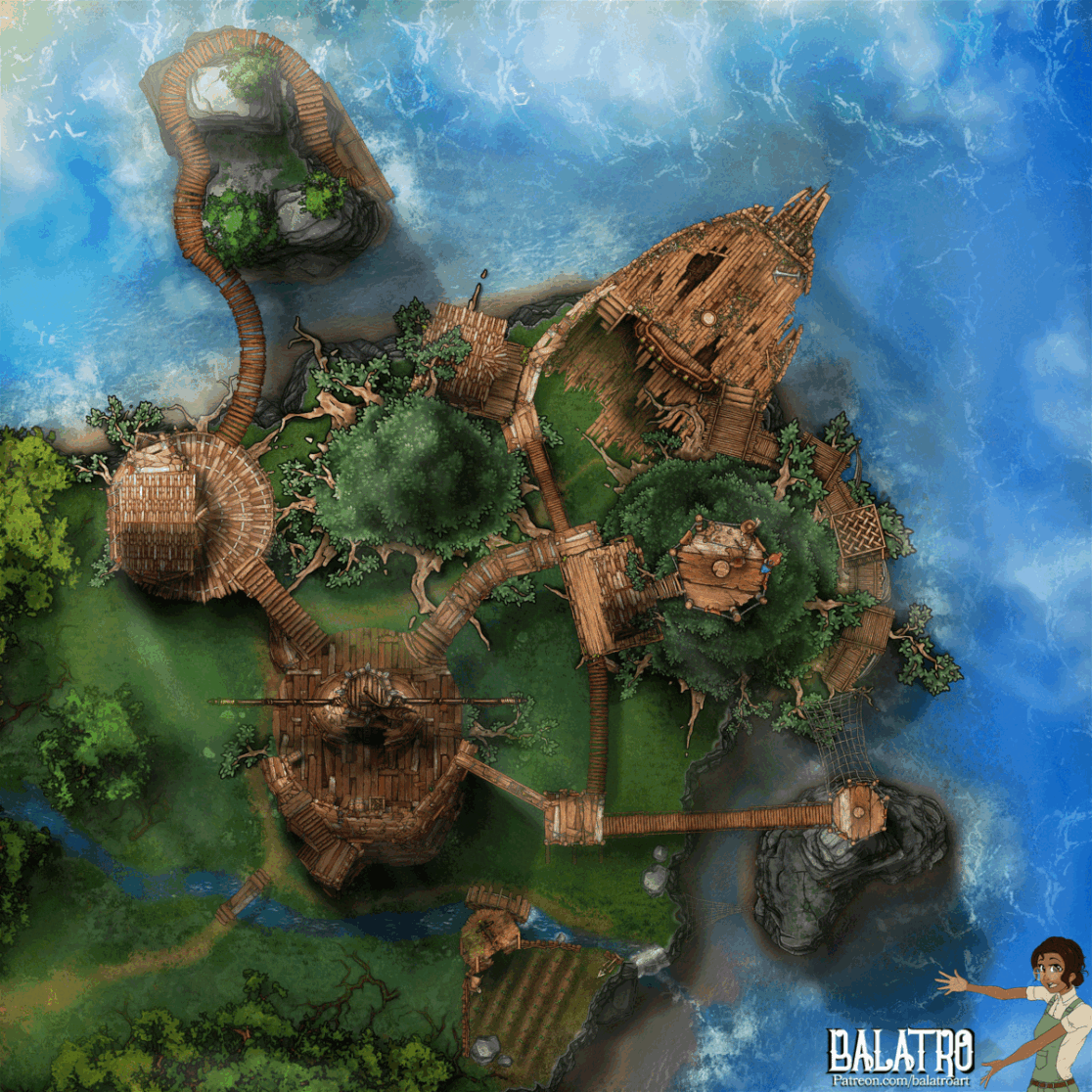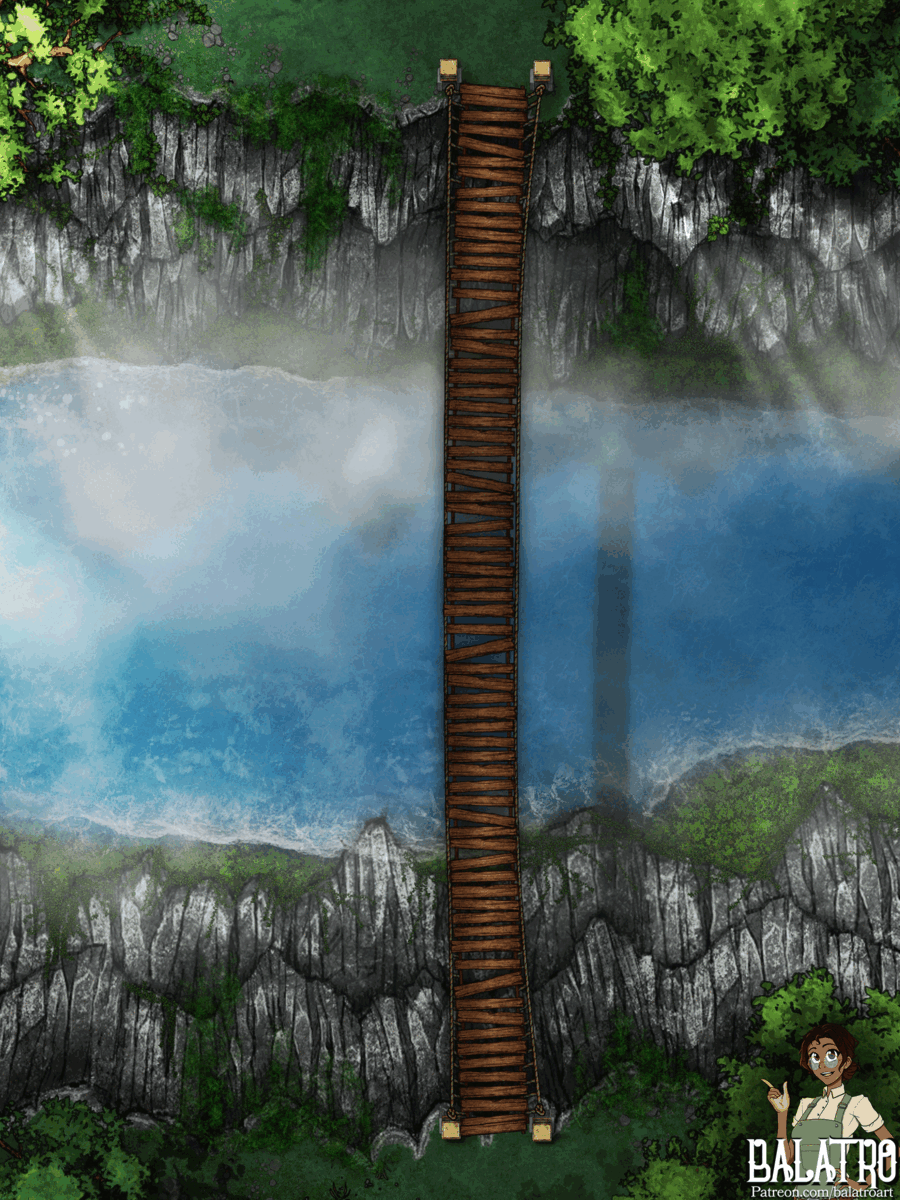
The Last Sea of
Triton
The lush thick jungles, sweltering seawater air, and bursting voltaic lava jets are the constant atmosphere of the islands of the triton sea. The only remaining ocean after the seas drained on the day of dawn. Home to the marauding pirates, orc Spiritualits, mysterious elemental gods, a shadowy growing army of monstrous creatures, and a massive city of bronze and gold where sits the "leader" of this land. The ape King Daj in his pyramid of gold under the silver monkey Idol.
The islands each have their own personality and dominant race and are like small worlds unto themselves. The seas that divide them are dotted with constant warring ships, canoes, and riding Piluna. The untamed and unexplored land is rich with diversity and culture but woefully lacking in trade and commerce due to the massive swell of pirates. Iron, steel and smiting are all but alien in the seas and such items fetch a high price. The tides are alive with mystery and adventure.
Battlemaps set in this location
Big Island
The largest island in Triton is dominated by a vast, uncharted jungle whose dangers are innumerable—not least of which are the Forgon tribes, who revere the long-dead Gator Kings. These tribes trace their lineage to a time thousands of years ago, when their race ruled as lords under The Brood, a coalition of monstrous creatures unified by conquest. Now confined to the jungle by the human settlers, the Forgon capture trespassers, turning them into prisoners and supplicants. These unfortunates are forced to offer pitiful prayers in the damp, moss-covered ruins of ancient temples.
Beyond the raiding Forgon, countless terrors lurk beneath the jungle canopy. Zakurad, the hydra who prowls just beyond the shores, is but one of many dangers. Deeper in the dense wilderness, explorers risk encountering horrors such as the salt-pillar-creating Medusa, the cunning Naga, and perhaps the greatest threat of all: the lost city of the snake mutants, the forbidden Azsrighil.
Few have ventured more than a mile into this thick, unforgiving terrain and returned alive. Some have returned... undead. their lifeless eyes forever unblinking for the horrors witnessed.
Kahier Roost
Perched 1,000 feet above the ground at the tops of a dense jungle canopy, Kahier Roost is a breathtaking settlement of tree houses. It serves as the secluded home of the western aarakocra, an isolationist community of bird-folk who prefer to keep far from the rest of civilization. Their roost houses are constructed to be entirely inaccessible to ground-dwellers. With appearances reminiscent of gulls, pelicans, and other sea birds, the aarakocra leave their roosts in flocks each day to fish the western sea. With nets and diving techniques, they work together and return as a united flock.
This relatively simple lifestyle has sustained them completely. Aside from the occasional youngling embarking on a personal journey, the aarakocra have lived in uninterrupted peace for hundreds of generations, a far cry from the days when their ancestors built the fabled golden city of A’teran thousands of years ago.
Hagjaw Islands
The Hagjaw Islands are a scattered chain of small, fragmented landmasses, each with its own unique climate and extreme environments. This diversity is matched by the rich variety of cultures inhabiting the islands, each one home to distinct communities of kenku. Known for their wild array of feathers, features, and abilities, the kenku of the Hagjaw Islands are a subject of fascination and intrigue throughout the region.
Among the most renowned of these inhabitants are the parrot kenku, whose mimicry is legendary. Like all kenku, they are natural mimics, but their abilities push this trait to the next level. They can flawlessly replicate entire songs, adopt full personalities, and even imitate a wizard’s spell after witnessing it cast.
Mount Kaika
Mount Kaika rises dramatically over northern Triton, a towering natural landmark that serves as a boundary between the untamed bay of wild Triton and the carefully controlled, patrolled seas of Okugai. Its imposing presence serves as the clear line between the chaotic freedom of the bay and the strict order of the Okugai waters.
Lafit
Lafit is a desolate mud and saltmarsh island, its landscape dominated by dense swamps and teeming with anacondas and alligators. Harsh and unwelcoming, few dare to visit this unforgiving place. Yet, at the island’s heart lies a small stilted town, a ramshackle refuge often used as a safe haven for criminals and pirates seeking to evade capture.
Ambrosia Karst
Ripped from the cliffs of Triton Bay, the Ambrosia Karst is a monumental formation and one of the few known gateways to the Sunless Sea. Its cavernous maw plunges into the dark waters beneath the world, where the hidden ocean depths merge with the open sea. Mysterious and foreboding, the karst is a rare place of wonder, drawing explorers and daring sailors despite the dangers lurking within its shadowy expanse.
New Collora
Nestled amidst rolling vineyards and blessed with golden sunsets over the western sea, New Collora is a bustling port city that serves as the gateway between the Plains of Avarice and Triton. Once renowned for its towering statue of King Infante, the monument was dismantled during the civil war; only its sword was spared, the rest melted down and forged into firearms for the conflict.
Today, with the war long behind, New Collora thrives in an artistic renaissance. Brilliant creative minds from across the world flock to the city, drawn by a surge of creativity and generous patronage that has transformed it into a beacon of cultural beauty.
Fort Cazario
Situated along the eastern bay outside of A'teran, Fort Cazario occupies a vast swath of jungle cleared to make way for a colonial fortress. Originally constructed by the Colloran conquistador forces as a counteroffensive stronghold during a conflict with the southern Dawnfire navy and their hired privateers, the fort served as a shield against the relentless looting of Colloran trade ships.
Ironically, the fortress has outlasted the very nation that built it. Refusing to relinquish his rank, the conquistador commander Abril of Fort Cazario has unified his remaining soldiers. Now, he sets his sights on A'teran, vowing to conquer the city and establish it as the new stronghold of Colloran Royalist ideals.
Tartarus Peninsula
Jutting out from Big Island into Triton Bay, the Tartarus Peninsula forms a rugged, rocky U-shaped landmass, its surface cloaked in thick beds of moss and barnacles. This windswept expanse serves as a sacred meeting place for orcs who engage in ritual combat. Here, under witnessed by all three elemental gods and their guardians, the victor’s fate is decided by divine will.
This ancient tradition predates the naming of the landmass itself, rooted in the earliest days of orcish culture. The peninsula earned its name from the legendary Warchief Tartarus, who challenged and defeated the leaders of the three great orcish nations, uniting them into a single, mighty army. However, Tartarus’s ambitious campaign for dominance ultimately failed, his armies disbanding and returning to their homelands after his demise.
In modern times, a fanatical group known as the Brides of Tartarus has emerged on the peninsula. Dedicated to the resurrection of the fallen warchief, they gather followers with the aim of fulfilling his long-lost dream of conquest.
Mount Gormal
Rising from the heart of Big Island, Mount Gormal pierces through the dense jungle canopy, its emerald slopes shrouded in perpetual mist. This towering green peak dominates the Triton Bay skyline, its silhouette an ever-present feature, visible from nearly any point along the waters. The mountain serves as a directional beacon for adventurers and explorers.
Glow worm Goblin Hive
The Glow Worm Goblins are an extraordinarily rare and fortunate hive, having developed a unique symbiotic relationship with a species of luminous worm native to the jungle. These worms disrupt the goblins' typical meteor-induced mitosis and self-cloning life cycle, enabling them to live ten times their usual lifespan. This prolonged life expectancy has allowed the goblins to develop advanced intelligence and communication skills, elevating their culture far beyond the primal instincts of most goblin hives.
Zealously hidden from the outside world, the hive fiercely protects the glow worms, viewing them as sacred harbingers of a brighter future. To the Glow Worm Goblins, this relationship represents not only survival but the dawn of a new evolutionary era for their kind.
Temple of Mara
Located at the heart of the Big Island, just south of Mount Gormal, the Temple of Mara is dedicated to the Ninoten guardian protector of Galu, the elemental god of the sea. Mara is depicted as a Rakshasa adorned with a hook-fanged jade mask, frozen in a furious, screaming expression. She embodies the temperament of the Galu and the fury of the sea, personifying relentless storms, surging tides, and the balance of floods and droughts. Mara is considered both fickle and uncaring, her wrath devastating.
Shrines to Mara are scattered throughout the region, where offerings are made in futile attempts to placate her rage. It is widely understood that such efforts are almost always in vain. The Temple of Mara is a converted cavern, shaped by an underground river that feeds the roaring rapids leading to Keelhaul Falls. Once home to a thriving community of Mara’s cultists, the temple met a tragic end when a sudden flood consumed it entirely, sealing her worshippers inside. Many interpreted this violent end as an omen, a warning against devoting one’s life to such an unforgiving deity. To this day, the temple remains a flooded ruin, its depths shrouded in mystery and avoided by most—except for the occasional adventurer or desperate soul seeking to challenge the wrath of the Mara.
Waters of Wog
In the vine-choked regions of the jungle, where every inch of land is suffocated under endless ropes of green and dense blades of fern, moss-covered stones peek through the undergrowth. These stones are the remnants of a once-mighty temple, now consumed by the wilds and bisected by a steady river. Among the ruins stand colossal statues of frogs, their agape mouths pouring water endlessly into the stream, as if frozen in some eternal ritual.
The myths of this place speak of the origin of the Bullywog—monstrous frog-like humanoids that haunt the region. Their society today is a shadow of what it might have once been, with no known history or stories passed down. The Bullywog of the present have lost the ability to speak, living only to hunt and kill their prey. What caused this decline remains a mystery, though some whisper of a curse or a forgotten calamity that doomed their ancestors.
The dense tangle of vines and labyrinthine jungle of the Waters of Wog hides secrets that few dare to uncover. Adventurers speak of strange echoes, ancient carvings overgrown by moss, and fleeting glimpses of something far older and more menacing than the Bullywog that now inhabit the ruins. Some kind of monstrous amphibian with skin like stone and three tongues. But no one has ever gotten a detailed look at it- At Least no one living.
Guillotine Point
A jagged bedrock mountain spearing out of the most turbulent, rocky waters of Triton Bay, Guillotine Point is infamous as a perilous ship graveyard. The surrounding seas are choppy and unpredictable, cloaked in a constant haze of fog that obscures vision and hides the countless hungry sharks below. The island’s sharp, craggy cliffs and treacherous waters have claimed many unwary vessels, their wreckage scattered like broken bones peeking up through the roiling surf.
At the heart of this shattered island lies a narrow crack in the rocks, leading into a hidden fjord veiled by the ever-present fog. Within this secluded enclave, the Court of the Queen of Mermaids resides, her watery domain encircled by seaweed-strewn banks and barnacle-encrusted walls. The cliffs form a natural barrier, making the court a sanctuary both secretive and nearly impossible to access.
High above, at the peak of Guillotine Point, stands a shattered ship. According to legend, the ship was carried to the mountaintop by a colossal wave, the likes of which could only have been summoned by the enraged ocean god-beast Galu. The wreck, now splintered and weathered by time, hangs like a corpse on display, visible for miles.
Cracklin Reserve
Once a lush and thriving island perched atop rocky seastacks off the coast of New Collora, the Cracklin Reserve is now a barren desert island. Formerly the operational hub of the Cracklin Syndicate, a dwarven shipping and trade organization, the island fell into decline when the syndicate went bankrupt. Their holdings, including the Reserve, were acquired by the Ebonvault Bank of New Collora. In the aftermath, the island was systematically stripped of every ounce of value—its timber, artifacts, and even some structures were dismantled and sold off. The ruthless exploitation left the island utterly depleted, and over time, its once-diverse ecosystem collapsed, leaving the island desolate.
Today, the Cracklin Reserve remains officially owned by the Ebonvault, but in reality, it has been abandoned. Or so it would seem. Beneath the island’s surface, a thriving smuggling operation takes place. Pirates and thieves have claimed the island’s sea caves, using them as a hidden base to hoard stolen goods from passing trade ships. These contraband items are funneled into the black markets of New Collora, fueling a shadow economy that operates right under the noses of the city’s lawkeepers.
The Devil's Garden
The Devil's Garden is infamous as the origin of the deadly Devil’s Lily. This unique plant features a helixed stem containing two separate saps. When these saps mix—typically from a careless step or disturbance—the chemical reaction produces an extremely sticky substance that rapidly heats to dangerous temperatures. In the dry season, the reaction can even ignite fires, earning the flower its name.
Located south of Keelhaul Falls, the Devil's Garden is a sprawling field of these dangerous blooms. The flowers vary in size and some subspecies of the Devil’s Lily can grow to an astonishing six feet tall. This natural phenomenon, while mesmerizing from a distance, is treacherous to navigate. It remains one of the most hazardous landscapes in the region, attracting both adventurers and cautious botanists hoping to study its volatile flora.
Oneya Lighthouse
Perched atop a craggy cliff, the Oneya Lighthouse resembles a fusion of castle parapet and wizard’s tower. This towering structure is the domain of the enigmatic “Mr. Stitches,” a reclusive figure whose experiments delve into blurring the boundaries between life and death, the mortal world and purgatory. From the arrow slits near the tower's summit, an eerie green light spills into the night—a product of Mr. Stitches’ arcane alchemy and sorcery. This spectral glow serves as a beacon for sailors braving the stormy waters, earning the lighthouse its name.
Despite its utility, Oneya Lighthouse is shrouded in mystery. Mr. Stitches remains a complete recluse; although many claim to have glimpsed him, none can definitively describe his appearance. Whispers of his existence stir both fear and curiosity, with tales ranging from him being a stitched-together abomination to a ghostly figure who never truly belonged to the world of the living. His motives, like the man himself, remain hidden within the tower's stone walls.
Mau'Afi
The Mau’Afi are devoted followers of the Earth Father, elemental god of land Afi. This orcish nation is easily recognized by the long red ribbons woven into their hair and garments, symbolizing Afi’s lifeblood, magma. The heart of their nation is Soudak’Afi, a towering city built within the jagged fissures of a volcanic vent. Rising from the depths with its structures seamlessly integrated into the rugged terrain. A vast network of roads crisscrosses the island, carved from ancient lava tubes.
Asna'Galu
The Asna’Galu are devout followers of the Sea Beast, Galu, a primal deity revered as the keeper of the tides and the arbiter of wisdom. This orcish nation lives in harmony with the ocean, their lives centered on fishing, seafaring, and the pursuit of balance. They believe that only the wise will be spared when the great floods rise, and Galu drowns the land at the end of days.
The Asna’Galu hold wisdom as their highest virtue, viewing it as the key to understanding the Sea Beast’s will. Their villages are built on stilts above tidal flats or anchored to rocky shores, with homes crafted to withstand the ebb and flow of the sea. Their traditions are steeped in oceanic rituals, and their songs echo with the rhythm of the waves.
Nu'Lagi
The Nu'Lagi are the devout followers of Lagi, the Sky Mother, revered as a tempestuous deity embodying the vastness of the heavens. This orc nation makes its home on high cliffs and rugged plateaus, where they believe they are closer to Lagi’s domain. Known for their technological ingenuity, the Nu'Lagi are the most advanced of the orc nations, mastering airships and gauge technology. They view these innovations as divine gifts that bring them closer to Lagi’s will, granting them dominance in war and navigation.
Nu'Lagi warriors dust their skin with grey charcoal and dye their flesh to resemble the ashen hues of storm clouds. This connection to the volatile sky is reflected in their culture, with virtues surrounding dynamic shifts and change and the strength of the warrior. Among the three great orc nations, the Nu'Lagi are the most warlike and driven.
Tiberius Reef
Marking the boundary between Triton Bay and Keelhaul Coast, Tiberius Reef is a sprawling maze of jagged coral and treacherous waters. It is notorious as the hunting ground of Rayray, an infamous oceanic psychopath whose humanoid shark monstrosities roam the area relentlessly.
For travelers and merchants, passing through Tiberius Reef without the Sharks’ permission—or payment—is a risky endeavor. Their tolls are high, but the alternative is far worse: an encounter with the Sharks, whose unmatched sense of smell makes escape nearly impossible. And the reef itself is a natural labyrinth, with sharp coral formations and hidden underwater currents that can disorient even seasoned navigators. Rumors claim that those who attempt to sneak through the reef uninvited are butchered down to a single man who is allowed to survive, their vessels splintered on the coral while the sea runs red with the blood of their crewmates.
Atlantis
Atlantis is the ancient home of the Atlantians, a subaquatic species of hyper-adaptive humanoids capable of personal evolution at a rate unmatched by any other beings. What takes other races countless generations of adaptation, the Atlantians achieve in one lifetime with mere months, adapting perfectly to their environment.
The city itself is unparalleled in Crudilex, being the oldest in existence. According to legend, Atlantis was constructed by the creator god as the seed of life for the entire world. Its walls are adorned with carvings and murals depicting its divine origins and the spreading of life across the land, an embarrassed account of every area of Crudilex’s history. For thousands of years, however, Atlantis has lain submerged beneath the tides, lost to history as myths of its grandeur faded into obscurity. Recently, the Atlantians have resurfaced, emerging from their aquatic isolation to interact with the rest of mortalkind.



